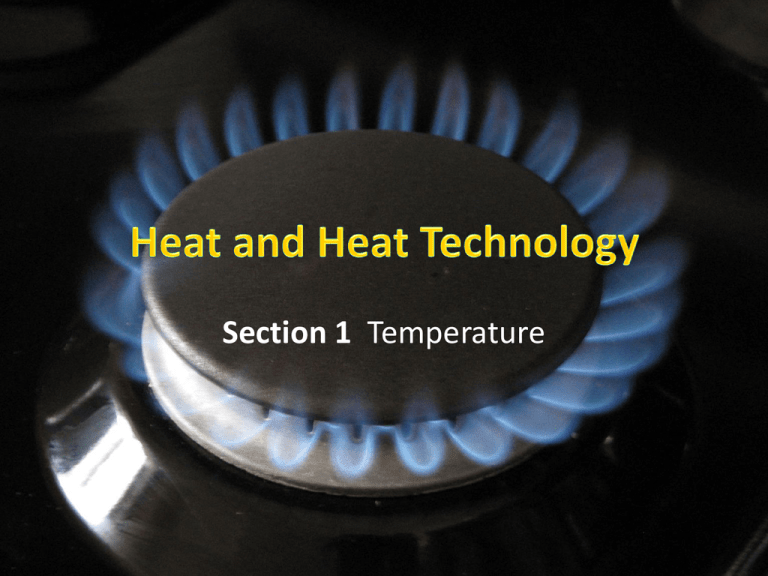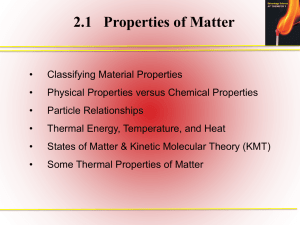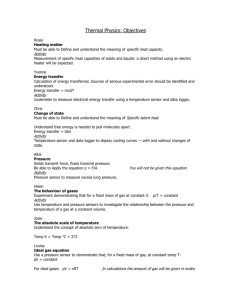Heat and Heat Technology
advertisement

Section 1 Temperature • Describe how temperature relates to kinetic energy. • Compare temperatures on different temperature scales. • Give examples of thermal expansion. • Temperature is a measure of kinetic energy. • Kinetic energy is the energy of motion. All moving objects have kinetic energy. • Kinetic energy of an object depends on the object’s mass and speed. • All matter is made of atoms or molecules that are always moving. • The faster the particles move, the more kinetic energy they have. • The more kinetic energy an object has, the higher the temperature of the object. • The gas particles on the right have more kinetic energy than those on the left. So, the gas on the right is at a higher temperature. • Motion in matter is random, so each particle has a different amount of kinetic energy. • An object’s temperature is the average kinetic energy of the particles in the object. • Thermometers can measure temperature because of thermal expansion. • Thermal expansion means that when a substance’s temperature increases, its particles move faster and spread out – creating more volume (expansion). • The Celsius scale is the most widely used temperature scale. • The Fahrenheit scale is the one we use in the US. • The Kelvin scale is the official SI temperature scale. –The lowest temperature on the Kelvin scale is 0 K, which is called absolute zero. • Temperature is represented by different numbers on the three temperature scales. • Expansion Joints on Highways –Hot weather can make a bridge expand as the bridge expands, it is in danger of breaking. • Expansion joints keep segments of the bridge apart so that they have room to expand without the bridge breaking. • Bimetallic Strips in Thermostats are made of two metals stacked in thin strips. The metals expand at different rates, a strip coils and uncoils in response to changes in temperature, as shown below. Section 2 What is Heat? • Define heat as thermal energy transferred between objects at different temperatures. • Compare conduction, convection, and radiation. • Use specific heat capacity to calculate heat. • Heat is the energy transferred between objects that are at different temperatures. • Energy is always transferred from the object that has the higher temperature to the object that has the lower temperature. • Heat is transferred in the form of thermal energy. –Thermal energy - total kinetic energy of a substance. • Thermal energy depends on temperature and on how much of a substance there is. • Thermal Equilibrium – when objects that are touching reach the same temperature • When objects are at thermal equilibrium no net change in the thermal energy of either one occurs. • Thermal Conduction - transfer of thermal energy through direct contact. –Conduction can also occur within a substance. • When particles of a substance touch, kinetic energy is transferred until the energy (and temperature) is even throughout. • Thermal conductors – substances that conduct heat well –Ex: most metals • Thermal insulators – substances that do NOT conduct heat well –Ex: wood and plastic • Convection - transfer of thermal energy by the movement of a liquid or a gas. –Takes place because of density –Warmer liquids rise, then begin to cool back down –Cooler liquid sinks and then begins to warm back up –The cycle repeats • Radiation - transfer of energy by electromagnetic (EM) waves. –All objects radiate EM waves. • Radiation can involve either a transfer of energy between particles of matter OR an energy transfer across empty space. –Ex: warmth of the sun • Radiation and the Greenhouse Effect –Earth’s atmosphere allows the sun’s visible light to pass through it. –The atmosphere also traps energy within its’ gases, too. • This process is called the greenhouse effect. Without it, Earth would be a cold, lifeless planet. • Global warming concern: if too much energy is trapped in the atmosphere, the Earth may become too warm • Specific Heat - energy needed to change the temperature of 1 kg of a substance by 1°C. –Higher the specific heat, the more energy it needs to increase its temperature. • Most metals have lower specific heats. • Specific heat of water is very high. • heat (J) specific heat (J/kg•°C) mass (kg) change in temperature (°C) • Calculating Heat - When the temperature increases, the value of heat is positive. • When the temperature decreases, the value of heat is negative. Section 3 Matter and Heat Essential Questions • Identify the three states of matter. • Explain how heat affects matter during a change of state. • Describe how heat affects matter during a chemical change. • Explain what a calorimeter is used for. States of Matter • State of matter - the physical forms a substance –solid, liquid, and gas (and plasma) • The state of a substance depends on the speed of its particles, the attraction between them, and the pressure around them. Changes of State • Changes of State are physical changes – changes from one state to another • Changes of state include freezing (liquid to a solid), melting (solid to liquid), boiling and evaporation (liquid to gas), condensation (gas to liquid), and sublimation (solid to gas). • Temperature is the SAME during a change of state, whether the temperature is increasing or decreasing Heat and Chemical Changes Heat is also involved in chemical changes • During a chemical change, a new substance is formed. • –Sometimes a chemical change requires heat • Ex: baking a cake –Sometimes a change releases energy in the form of heat • Ex: wood burning • Food and Chemical Energy –Food gives your body energy. –Energy is released in a chemical reaction when compounds such as carbohydrates are broken down in your body. • The energy is released in chemical reactions. • Calorie – unit used to measure the amount of energy in food • Calorimeters - a device that measures heat. The energy lost by one object is gained by the other object through thermal energy. Section 4 - Heat Technology Essential Questions • Analyze several kinds of heating systems. • Describe how a heat engine works. • Explain how a refrigerator keeps food cold. • List some effects of heat technology on the environment. Heating Systems • Hot–Water Heating - the high specific heat of water makes it useful for heating systems. Warm–Air Heating •Air cannot hold as much energy as water can. •Warm–air heating systems are used in many homes & offices in the U. S. • Heating and Insulation –Insulation reduces the transfer of thermal energy. –Insulation is used buildings so less heat passes into or out of the building. • Solar Heating systems use the sun’s energy to heat houses and buildings. Heat Engine • Heat engine - a machine that transforms heat into mechanical energy, or work. • Combustion – how heat engines use fuel • External Combustion Engines – burns fuel outside the engine –Ex: steam engine • Internal Combustion Engines – burns fuel inside an engine –Ex: car engine –Fuel (gas) is burned inside the engine, inside the cylinders. –The cylinders go through a series of steps to burn the fuel. • Cooling systems move heat OUT of an area • Cooling and Energy - The compressor does the work of cooling by compressing the refrigerant. The refrigerant is a gas that has a boiling point below room temperature, which allows it to condense easily. • A negative effect of thermal energy is thermal pollution, the excessive heating of a body of water. • Thermal pollution can happen near large power plants, which are often located near a body of water –It can effect the ecosystem in the area







